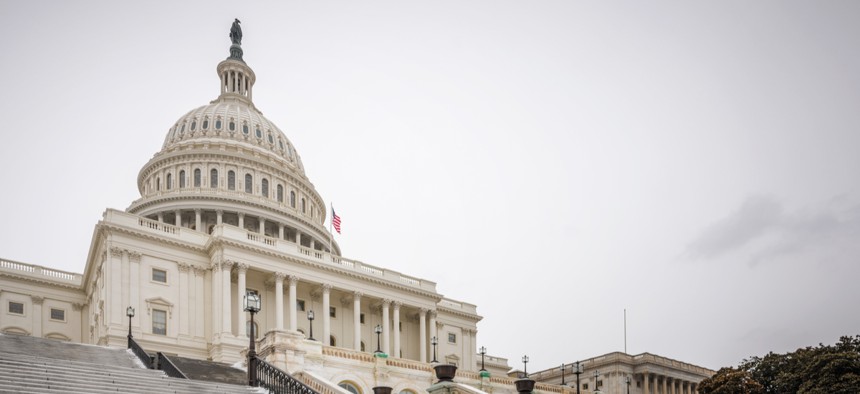House Dems Unveil Stimulus Plan Including Paid Childcare, Mandatory Telework and Bonus Pay for Feds

S.Borisov/Shutterstock.com
Measure comes with a $2.5 trillion price tag and includes provisions to rescind Trump's efforts to weaken federal employee unions.
House Democrats have proposed a new economic stimulus plan in the wake of the novel coronavirus pandemic, offering policies affecting federal workers including paid child care, mandatory telework for many employees and bonus pay for those on the front lines of fighting the outbreak.
The Take Responsibility for Workers and Families Act (H.R. 6379) would provide $2.5 trillion to agencies and Americans directly, including through checks of up to $1,500. Federal workers required to work during the crisis would be eligible to receive up to $2,000 in reimbursement for child care costs per dependent child. It would require any employee with a telework agreement in place to work remotely through the end of the year. Agencies would be prohibited from instituting any organization-wide limitations on telework and would have to report to Congress if their telework rates dipped. Each agency would have to report annual goals to boost their telework usage rates.
Employees who are directly treating individuals diagnosed with COVID-19, or those with “frequent, unavoidable contact” with the public, including Transportation Security Administration screeners, would be eligible for hazard pay. The measure would also ensure employees whose offices are closed, but who also cannot telework, are eligible for paid “weather and safety leave.” It would also create a presumption that any federal employee who contracts the coronavirus did so on the job and is therefore eligible for workers’ compensation.
Senate Democrats and White House officials are currently negotiating a separate measure, with key players suggesting Tuesday morning a deal could be imminent. It is unclear which of the House’s federal workforce proposals, if any, would make it into that version of a stimulus package. The House may put aside its own bill to instead take up the Senate agreement.
House Democrats have faced some criticism from their Republican counterparts for including provisions unrelated to the immediate crisis. Those provisions included some related to the federal workforce, such as a proposal to revoke three Trump-signed executive orders and one memorandum that sought to weaken federal employee unions and hasten the disciplinary process. The orders have limited federal union members’ ability to conduct representational duties while on the clock at their agency jobs, provided more authority to agencies to upend collective bargaining agreements and eased the process by which agencies punish misbehaving or poorly performing workers. They were briefly struck down by a federal judge, but later reinstated by an appeals court. Trump’s memo sought to exempt the Defense Department from any obligation to collectively bargain with its civilian workforce.
The House bill would rescind all four documents.
In a boon for U.S. Postal Service employees perhaps concerned about workforce contractions as a result of an economic downturn—as seen during and subsequent to the 2008 financial crisis—Democrats proposed a cash injection of $25 billion to the cash-strapped agency. It would also eliminate the $11 billion in outstanding debt USPS owes to the U.S. Treasury, and allow it to borrow $15 billion. The mailing agency, which is also struggling with its own coronavirus outbreak, would see new business from an expansion of vote-by-mail across the country.
The bill also includes $3 billion for the Technology Modernization Fund, a revolving fund from which agencies can apply for loans to support major IT upgrades and repay over the course of three to five years.
To date, Congress has appropriated $150 million for TMF—an initial $100 million outlay and $25 million annually in the last two budget cycles. While the $3 billion number seems extreme by comparison, the original proposal for the fund suggested it should start with $3.1 billion. At the time, federal IT leaders wondered whether even that figure would be enough.
Veterans Affairs would also get $3 billion under the proposal to support increased demand for telemedicine during the outbreak.
With cybersecurity touching every aspect of modern society, House appropriators also tucked $14.4 million into the bill for the Cybersecurity and Infrastructure Security Agency, or CISA, the frontline cybersecurity agency within the Homeland Security Department. The funds would be earmarked to “assist interagency critical infrastructure coordination, enhance analytic capabilities supporting coronavirus response, and related activities.”
Several agencies, such as the departments of Homeland Security and Interior, would receive funding for employee overtime during the crisis. Many agencies would see increased appropriations to expand their telework capacities and to dramatically increase their purchases of personal protective equipment for workers. Some agencies, such as the State Department, U.S. Agency for International Development and Agriculture Department, would receive funds to conduct emergency evacuations of their personnel stationed overseas. Virtually every agency in government would see a funding boost to ensure continuity of operations and to expand services during the pandemic, with Democrats largely far exceeding the requests the Trump administration submitted last week.
The bill also would create a Coronavirus Accountability and Transparency Committee of independent inspectors general to audit the massive spending authorized under the bill.
Aaron Boyd contributed to this report.






